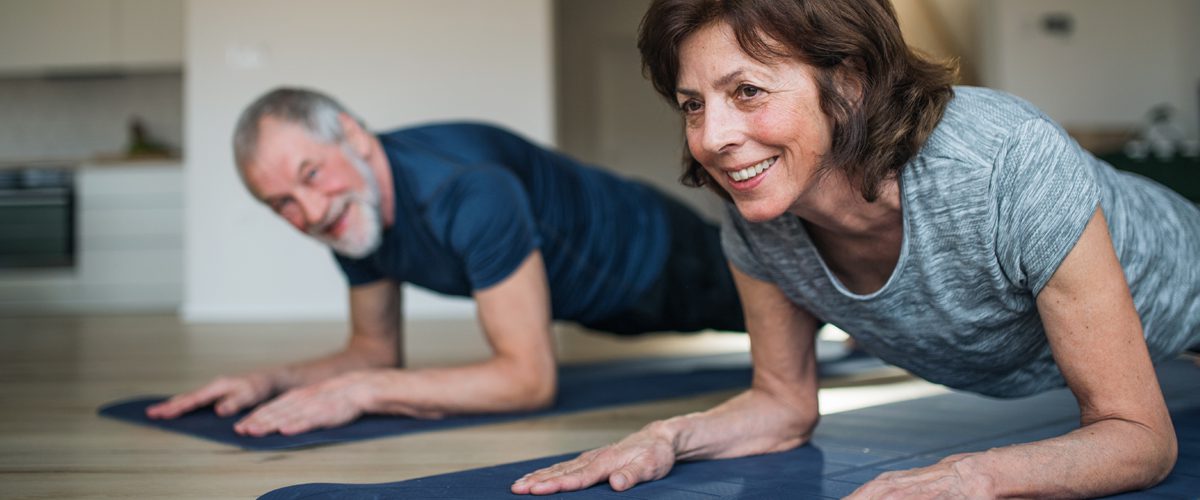How These Simple Static Exercises Can Improve Cardiovascular Health
A sports medicine expert explains how isometric exercises can be easily incorporated into daily routines — and make a big difference in people’s health.


Between work, family and social events, working out can often get moved down on the priority list. But effective exercise doesn’t have to be time-consuming or require fancy equipment. In fact, there is a growing body of evidence indicating that incorporating short bursts of exercise into everyday activities — running up the stairs in your home or office instead of walking for example — can make a difference towards improving a person’s overall health.
Among the types of quick, simple exercises that can effectively activate the muscles are isometric exercises, which involve contracting muscles while holding one position. A recent study found that these exercises helped reduce blood pressure in people with preexisting hypertension.
“People are busy and may not feel like they have the time to go to the gym for an hour and do traditional weightlifting or exercise regimens,” says Dr. Elan Goldwaser, a pediatric and adult sports medicine physician with NewYork-Presbyterian Westchester. “By doing isometric exercises a few times a day for a few minutes and getting in these quick bursts of activity, you can build up enough exercise to improve blood flow and keep yourself healthy.”
Dr. Goldwaser, who is also an assistant professor of Sports Medicine at Columbia University Vagelos College of Physicians and Surgeons, explained how isometric exercises work, how they are a good fit for people with limited mobility, and how they can be incorporated into a short, high-intensity workout regimen to help meet exercise goals.

Dr. Elan Goldwaser
What are isometric exercises?
Dr. Goldwaser: With isometric exercises you are contracting a set of muscles without moving your joints or limbs. In contrast, concentric exercises, like a bicep curl, and eccentric exercises, like squats, focus on movements to lengthen the muscles. Isometric exercises are done in a static position and help stabilize and strengthen muscles.
What are some examples of isometric exercises?
Wall sits, where you hold yourself in a seated position with your back against a wall, and planks, where you hold what looks like a push-up position, are fairly common isometric exercises. But those can be difficult for people with pre-existing orthopedic conditions. There are easier options, like knee extensions, where you straighten your leg and hold that position while squeezing your thigh muscle. You’ll still get an intense isometric exercise, but it’s less rigorous on the body.
For people interested in engaging in isometric exercises, I recommend beginning with something like holding a position for 10 to 20 seconds and doing that two times with a two to three minute break in between. As your body becomes conditioned to this, you can increase to 20 to 30 second holds and do three repetitions. The key is to increase slowly as you feel stronger, so you don’t overdo it and hurt yourself.
How can isometric exercises help with blood pressure?
When you squeeze the muscle and contract it, the idea is that you’re squeezing blood into the muscle to help promote flow. And then in turn, you’re also helping with the pumping of your blood, which strengthens your heart in ways that are similar to traditional exercise like running. As the heart gets stronger, it’s able to pump blood more efficiently, which can decrease your blood pressure.
Besides lowering blood pressure, what are some other benefits of isometric exercises?
The benefits are numerous. A person’s cardiovascular system is one giant network of blood vessels, all connected to your heart. As you exercise and build endurance with isometric exercises, you’re promoting good blood flow throughout the body, which nourishes the brain. Studies have also shown that in people with arthritis, isometric exercises are good alternatives for gaining muscle mass and joint stability compared to resistance-based exercises.
Are these exercises anyone can do?
Compared to traditional strength training, isometric exercises are safer, with lower metabolic requirements, meaning they take less energy. For people who are out of shape, who already have high blood pressure, or who have limited mobility due to arthritis, isometric exercises can be a more viable option for gaining the benefits of a traditional workout, such as greater endurance and muscle strength. Engaging the muscles without having to take knees or elbows through much motion or weighted stress can be very easy for those with arthritis or limited mobility.
You also don’t need a lot of equipment, space, or time to do these exercises. They can be done at home or even in the office, with just a wall or a chair. That’s why isometric exercises are great for these quick bursts of activity.
Are there risks to isometric exercises or short, vigorous workouts?
As with any exercise, the most important thing to remember is to warm up first and stretch. If your muscles aren’t warmed up before you try a wall sit or a knee extension, you can rip, pull or tear something. If you don’t regularly work out, you also shouldn’t go too hard too fast, as your body might be conditioned enough to handle such a quick increase in physical activity. If your burst of activity is too vigorous, you could quickly become overly fatigued and develop metabolic acidosis, which can cause you to throw up.
People should also make sure they are using the right form when doing isometric exercises. For example, if you let your back cave inward and your belly sag towards the ground when you are planking, you end up putting a lot of pressure on your lower back, which can increase your risk for injury or pain.
Should these exercises replace traditional workout regimens?
If you don’t have mobility issues, isometric exercises and short bursts of activity can supplement your regular workout. A recent study found that people who do a few minutes of daily vigorous activity can reduce their cancer risk by up to 32%.
The American Heart Association recommends at least 150 minutes of moderate-intense activity per week. This comes out to around 20 minutes a day of exercise. For people with mobility issues, those 20 minutes don’t need to be consecutive. As long as you build up around 20 minutes of moderate-intense activity over the course of your day, whether it’s isometric exercises or jogging up and down sets of stairs during the day, that can go a long way toward helping you stay healthy.
Additional Resources
Please visit NewYork-Presbyterian Westchester to learn more about their Orthopedics & Sports Medicine services.

